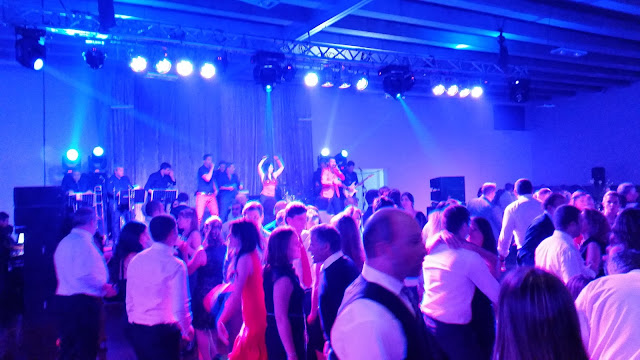 |
| The chuppah inside the sanctuary |
I was attending the wedding of my wife's cousin. The wedding took place in Santiago, Chile, so would be conducted entirely in Spanish along with Hebrew prayers.
 |
| Presentation of the couple |
shuffled in. Older people, young families, small children dressed in their celebration best. The sanctuary slowly filled to capacity.
The stated time of the wedding came and went. It was like being at a Kanye concert. Nearly an hour late, the groom, a young lawyer named Danny, made his way to the chuppah, the marriage canopy that reminded me of a pleasant pergola draped with a white sheet on the stage at the center of the sanctuary. Danny wore a kittel, a customary white cloak, over his dark suit. The blushing bride, my wife's cousin Josie, was escorted to the chuppah by her sister and mother.
 |
| Pre-dinner reception |
The chuppah represents the home the couple will create together, and the Divine Presence under which they will be married. The remainder of the ceremony took place under the chuppah, guided by a smiling Rabbi who did his best to ease the nerves felt by the young couple with both wit and warmth.
Danny lifted the veil over Josie's face, verifying that it was indeed this woman he intended to marry. The groom then replaced her veil, reciting the blessing "Our sister, may you be the mother of thousands of ten thousands" (taken from Genesis 24:60), words first uttered by Rebecca's mother and brother to her as she left her home to marry Isaac.
 |
| First dance |
A series of blessings were then recited by the Rabbi and his assistant. The first two blessings -- one over the wine and the second solemnifying the betrothal -- represented the first part of the ceremony. Next, two witnesses were called; they examined the wedding band to be sure that it met standards of Jewish law, namely being of one piece and without embedded stones. Danny placed the ring on his bride's index finger and formally declared her to be his wife.
 |
| Let the party begin! |
The Rabbi presented the couple to the audience, briefly described the traditions and meanings of the ceremony for those Gentiles among them, and sang the blessings that have been passed down for centuries. The ketubah, the Jewish prenuptial agreement, was read by the Rabbi. The groom then handed it to the bride for keeping.
The seven blessings that were then recited are among the most sentimental and beautiful of the Jewish liturgy, and are unparalleled expressions of joy. In a tradition at least 800 years old, the groom breaks a glass by stepping on it, symbolically remembering the destruction of the Temple in Jerusalem, destroyed by the Romans in the year 70 AD.
 |
| The bride and her girls. Danny being tossed to the right. |
The ceremony is over. With cheers and applause, the couple were escorted from the sanctuary and the reception would soon begin with cheers of Mazaltov!
After the ceremony, while still standing in the sanctuary, Josie's father, brother, and a couple other male relatives met to share the remainder of the wine used during the marriage. I was honored to be included in this brief custom, enjoying the wine straight out of a large golden chalice.
 The wedding dinner took place in a wide banquet hall in the basement of the synagogue. Dozens of round tables surrounded a stage and dance floor. Musical numbers were performed by a local band headed by two lead singers, a man and woman, who covered a wide range of popular favorites, in both Spanish and English.
The wedding dinner took place in a wide banquet hall in the basement of the synagogue. Dozens of round tables surrounded a stage and dance floor. Musical numbers were performed by a local band headed by two lead singers, a man and woman, who covered a wide range of popular favorites, in both Spanish and English.The raucous rhythms of Hava Nagila blasted loudly when Danny arrived. He and his friends danced in rapid circles, tossing Danny in the air, ties flapping, jackets flying, an amazing explosion of joy and celebration.
 |
| The men dancing in circles. |
My rusty Spanish skills proved to be no barrier to enjoying this party. Love and joy transcend language, religion, and culture. The food was good. The music was better. And I look forward to seeing Danny and Josie enjoy their new life together.
 |
| The band provides a steady stream of pulsing rhythms. |
 |
| Heading late into the night... |
 |
| Joining in a selfie with Josie the bride (front), her brother Andy and Andy's girlfriend. |
No comments:
Post a Comment